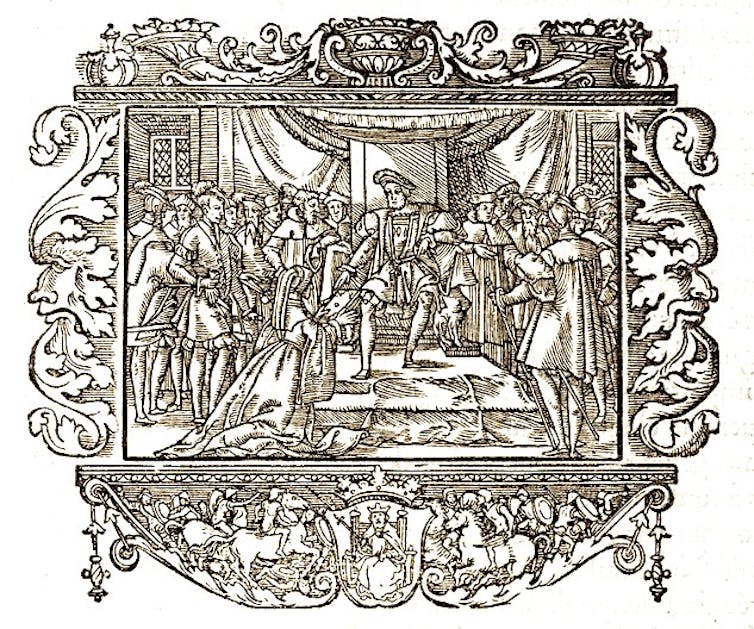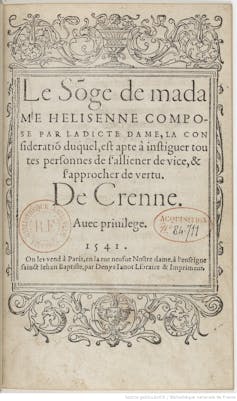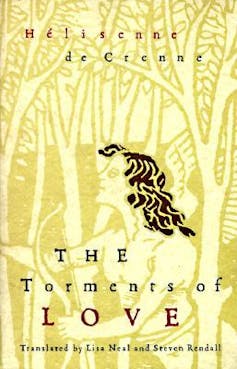Hidden women of history: Hélisenne de Crenne, the first French novelist to tell her own story
- Written by Susan Broomhall, Director, Gender and Women's History Research Centre, Australian Catholic University
In this series, we look at under-acknowledged women through the ages.
In 1538, a new author burst on to the literary scene in Paris. Published by Denys Janot, four new works appeared within five years by a writer known as Hélisenne de Crenne.
The first was Les Angoysses douloureuses qui procedent d'amours (The Torments of Love), a novel that depicted the disastrous consequences of an adulterous affair.
In 1539 came a collection of letters that explored women’s speech, education, friendship and legal rights among its topics.
In 1540 she published Le Songe (The Dream), a moral and didactic work in which a woman and her lover reflected upon the perils of lust.
Her last known work was a translation into French prose of the first four books of Virgil’s Aeneid (1541), dedicated to the king, Francis I.
Read more: Guide to the Classics: Virgil’s Aeneid
Hélisenne de Crenne was the pen name of Marguerite Briet, the daughter of a legal family from Abbeville. Few details of her life are certain, but we know that she obtained a legal separation from her husband, Philippe Fournel, Lord of Crenne, and moved to Paris, the centre of French literary activities and publishing. There she owned several properties. It appears that her son, Pierre, was a student there in 1548.
Hélisenne was the first living woman of the century to be printed in France and hers was the first autobiographical novel to be published in French. The publication of her works was remarkable in several ways.
 An illustration from the translation of Virgil’s verse depicts Hélisenne presenting it to the king.
Bibliothèque nationale de France
An illustration from the translation of Virgil’s verse depicts Hélisenne presenting it to the king.
Bibliothèque nationale de France
Read more: Fornication, fluids and faeces: the intimate life of the French court
Speaking out
Women represented less than 1% of all identifiable published authors in 16th-century France. Female literacy and broader education was not as high as for men at the same social levels.
Women at court were producing sophisticated intellectual and creative works that circulated in manuscript. Print publication provided a more open and visible expression than manuscript circulation, but was limited to a more select few. Even women in powerful social positions acknowledged expectations that women should restrict their speech to the domestic sphere.
Most women writers provided lengthy justifications or apologies for their venture into print. Hélisenne claimed to hesitate to make “mention of immodest love, which according to the opinion of some shy women could be judged more worthy to be conserved in profound silence than to be published for a widespread audience”. Nevertheless, she pressed on.
Rather than locate herself in a line of female authors, Hélisenne identified herself in a tradition of the male canon for her authority to write. The opening phrase of her Le Songe recalled none other than Cicero as her model:
…in imitation of him, the desire arose in me to relate in detail to you a dream worthy of recording.
Read more: Hidden women of history: Enheduanna, princess, priestess and the world's first known author
Small books to carry
Print publication offered a woman without elite networks access to a large pool of readers, and perhaps a way to reach potential patrons at court.
The dedication of her translation to Francis I and her praise of his sister, Marguerite de Navarre (another prolific author whose works appears in print over the course of the century), in her Letters suggests that Hélisenne may have hoped for their patronage.
 Le Songe de madame Helisenne Crenne (1541)
Bibliothèque nationale de France
Le Songe de madame Helisenne Crenne (1541)
Bibliothèque nationale de France
The staggered release of her writings seems to have been planned to heighten their impact. Her publisher, Denys Janot, mainly published works in French, targetting a popular market and using on-trend Roman typeface rather than the heavy, old-fashioned Gothic script.
Most of Hélisenne’s works, like those of other female writers, were in small sizes such as octavo, duodecimo and sextodecimo. These were portable and cheap, unlike the larger-sized folio and quarto scholarly and religious works intended to be consulted in libraries as part of a long-lasting record, though her translation of Virgil’s Aeneid was produced as a folio, with extensive woodcut illustrations.
A female perspective
Hélisenne was one of the first women writers who sought publication of her work seemingly as a conscious contribution to contemporary popular literature.
 Goodreads
Her novel, The Torments of Love, involves an unusual structure, retelling the same events from the perspective of three different narrators: Hélisenne, her lover Guénélic, and Guénélic’s best friend, Quézinstra. Each section offers new insights to the overarching narrative, and each has its own distinctive tone and style.
The work’s balancing of elements from chivalric literature and a new emotional sensibility culminates in its conclusion as a battle between Athena and Venus over the book itself.
Her translation of Aeneid was equally radical, creatively embellishing the original from a female perspective with a highly sympathetic presentation of Dido’s plight and women’s loyalty in love.
She was very proud of her publication in the city that was the intellectual and publishing centre of France, saying:
… it is an inestimable pleasure to me to think that my books are on sale in this noble Parisian city, which is inhabited by an innumerable multitude of wonderfully learned people.
Read more:
Hidden women of history: Catherine Hay Thomson, the Australian undercover journalist who went inside asylums and hospitals
A commercial success
Hélisenne’s work were a commercial success, going through nine editions in a short, intense period to 1560.
Goodreads
Her novel, The Torments of Love, involves an unusual structure, retelling the same events from the perspective of three different narrators: Hélisenne, her lover Guénélic, and Guénélic’s best friend, Quézinstra. Each section offers new insights to the overarching narrative, and each has its own distinctive tone and style.
The work’s balancing of elements from chivalric literature and a new emotional sensibility culminates in its conclusion as a battle between Athena and Venus over the book itself.
Her translation of Aeneid was equally radical, creatively embellishing the original from a female perspective with a highly sympathetic presentation of Dido’s plight and women’s loyalty in love.
She was very proud of her publication in the city that was the intellectual and publishing centre of France, saying:
… it is an inestimable pleasure to me to think that my books are on sale in this noble Parisian city, which is inhabited by an innumerable multitude of wonderfully learned people.
Read more:
Hidden women of history: Catherine Hay Thomson, the Australian undercover journalist who went inside asylums and hospitals
A commercial success
Hélisenne’s work were a commercial success, going through nine editions in a short, intense period to 1560.
 A nineteenth-century artist’s imagined Helisenne.
Wikipedia
Torments of Love is Hélisenne’s only work to be dedicated to female readers who she called “all honest ladies”. Elsewhere, she assumed her works would be of interest to everyone, including the king.
A later editor did not agree. Claude Colet explained in the introduction to the 1550 edition of her works that his extensive simplification of her Latinate style for young ladies was “to render the obscure words or those too much like Latin into our own familiar language, so that they will be more intelligible to you”.
The last known evidence of this groundbreaking author is in 1552 but, in her lifetime, she had achieved a remarkable series of literary firsts.
A nineteenth-century artist’s imagined Helisenne.
Wikipedia
Torments of Love is Hélisenne’s only work to be dedicated to female readers who she called “all honest ladies”. Elsewhere, she assumed her works would be of interest to everyone, including the king.
A later editor did not agree. Claude Colet explained in the introduction to the 1550 edition of her works that his extensive simplification of her Latinate style for young ladies was “to render the obscure words or those too much like Latin into our own familiar language, so that they will be more intelligible to you”.
The last known evidence of this groundbreaking author is in 1552 but, in her lifetime, she had achieved a remarkable series of literary firsts.
Authors: Susan Broomhall, Director, Gender and Women's History Research Centre, Australian Catholic University



